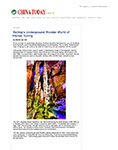Beijing’s Underground Wonder-world – where it’s always Spring |
 |
<<Click to see original |
If you are into the pursuit of spelaeology (the study of caves and other karst features), you will no doubt have heard of a cave in the southwest of Beijing known as Shihuadong. For those of us who may not have even heard of the term before, this 'Underground Pearl of Beijing' is well worth making the time to go and see.
The Shihuadong (Stone Flower Cave) is located in Nancheying Village in the magmatic national geological park of Fangshan District, about 50 kilometres from downtown Beijing. It was actually discovered in 1446 and is a seven-storey water-eroded cave, with a drop of 130 metres. At present, only the first four layers from the top are open to the public, offering a 2500-metre, nearly two-hour touring route.
The cave’s original name was Qianzhen, and it was discovered by a Chinese monk called Yuan Guang, during the Ming Dynasty. It covers an area of about 1.8 hectares, spread over twelve huge ‘halls’ which are interconnected with countless narrow passages, sixteen ‘chambers’ and 71 ‘branch caves’. The official blurb will tell you that there are up to 18 scenic areas and more than 120 different panoramas to enjoy, all divided into 16 halls.
The first chamber contains three large Buddha statues dating back to 1456, which means they were erected only 10 years after the cave was discovered. This is the reason why the cave was then renamed Shifo Dong which translates as Stone Buddhas Cave, before it was later renamed yet again to reflect the tremendous amount of stone ‘flowers’ lying around the floors of the cave.
The natural landscape inside the Stone Flower Cave is pretty amazing. You lose track of how many stalactites and stalagmites there are that have been formed by mineral deposits (primarily calcium carbonate) in dripping water over the aeons. (In case you get confused, the stalactites are the ones that hang from the ceiling and the stalagmites are the ones that grow up from the floor.)
In the No.1 Hall, there’s a huge stalactite hanging 18 metres and with a diameter of 3 metres, making it the biggest in China. Added to that there are stone curtains, stone waterfalls, stone troughs, masonry dams, stone terraces, numerous stone flowers, curling stones (helictites), crystal flowers, fur stones, stone chrysanthemums, stone pearls, stone grapes and goodness knows what else, all deposited by water, which has been dripping or flowing, percolating or splashing over countless millenia.
Above ground, the notices warn ominously that there are no toilets in the cave. ‘Please be prepared’, we are warned. Yet another sign imperiously says ‘No photography’; but everyone knows that prohibitions are only meant for other people, so we happily snap away in front of the official guide, who even points out some of the best spots from which to take the best pictures.
Some of the engineering is pretty impressive in this place. Where nature has not seen fit to provide a gentle slope to walk down, some gallant souls have installed walkways and staircases. Only four of the seven storeys are open to the public as of now, but no doubt someone, somewhere is planning the next staircase to even lower levels in the cavern.
You have to hand it to the management of this place. They have done their utmost to instil a sense of wonder in the visitors with their use of hyperbole and the descriptive names they have given to virtually every ‘landscape’ we pass. ‘The inside is a fairyland on earth. You will be amazed at nature's creativity,’ the official blurb gushes, as we pass by ‘Frolicking carps; Mirage Fairy Island; Chess ground; Crowing rooster; Heavenly Abode; Dragon coiling jade column; Bamboo fenced thatched house; Willow Shadow; Spring bamboo shoots; Blooming stalagmites; Greeting turtle’ and so on.
The ‘Immortal Appreciating Cascades’ are some of the most impressive formations. These are apparently the biggest stalactites in China and to do them justice, the management have different coloured lights fading in and out over them as we descend yet further into the bowels of the earth.
‘Everywhere is full of the sound of water dripping Di-Di-Da, which is composed into delightful music’ the blurb continues; and some of the formations are indeed reminiscent of organ pipes one sees in various gothic horror movies of the 1950s and 60s.
The entire cave network has a constant temperature of 13 degrees, meaning that you can basically expect spring-like weather all year round. This makes the caves an ideal storage place for maturing wine – a fact that has not gone unnoticed by the clever marketing people at Moutai who use the Shihuadong to mature a special edition of their baiju, which is only sold here in the cave to tourists who want to take back a souvenir of their time spent underground.
Our tour is almost over; but lest anyone is worried that what goes down must come up, although the cave is entered through a concrete tunnel leading to the first chamber, the cave is left from the second level, saving one’s leg muscles from the arduous climb back up.
{To get to Shihuadong, you should take the Fangshan Subway Line to Liangxiangnanguan station, exit A; from nearby you then take a 43
